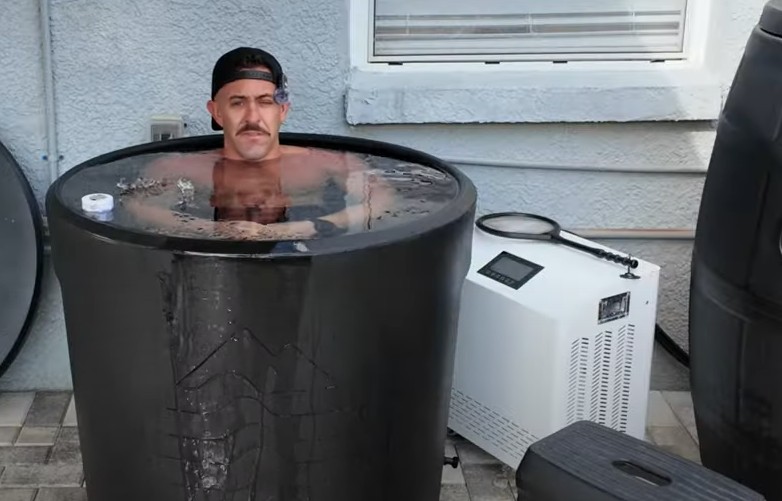Need help?
Unsure whether you need a bath or a plunge, portable or fixed, chiller or iced? Check out Sasha’s cold plunge vs ice bath article to answer all and get clarity on your cold immersion needs.
Contents
- 1 The Polar Plunge: An Introduction to Ice Bath Chillers
- 2 Implementing Ice Bath Therapy: A Step-by-Step Guide
- 3 Navigating the Challenges: Common Pitfalls and How to Avoid Them
- 4 Adapting Ice Bath Therapy to Different Scenarios
- 5 From Novice to Master: Building on the Basics
- 6 Exercises to Enhance Your Ice Bath Practice
-
7 People Also Asked
- 7.1 What temperature should you set your ice bath chiller?
- 7.2 How long should you stay in an ice bath?
- 7.3 Can ice baths help with muscle recovery?
- 7.4 Are ice baths safe for everyone?
- 7.5 How often should you take ice baths?
- 7.6 Can ice baths help with fat loss?
- 7.7 What’s the difference between an ice bath and cryotherapy?
- 7.8 Can ice baths improve mental health?
- 7.9 How do you prepare for an ice bath?
- 7.10 Can ice baths boost the immune system?
- 8 Key Takeaways
The Polar Plunge: An Introduction to Ice Bath Chillers
Standing on the shores of New Zealand’s South Island, the frigid waters of the Southern Ocean lapped at my feet. The invigorating chill sparked a thought: could I bring this sensation home with me?
An Ice Bath Chiller is a specialized devices that maintain water temperatures between 35°F to 75°F (1.7°C to 23.9°C). They create a controlled environment for cold water immersion, a practice that has gained significant popularity among athletes, health enthusiasts, and those seeking mental clarity.
>>Make sure you check out Greg’s post on the best chillers out there right now<<
Implementing Ice Bath Therapy: A Step-by-Step Guide
Now that we understand the underlying mechanisms, let’s explore how to effectively apply ice bath therapy using a chiller.
Step 1: Choosing Your Chiller
When selecting an ice bath chiller, consider factors such as temperature control precision, energy efficiency, and capacity. As an environmentally conscious person, I opted for an energy-efficient model that could maintain a stable temperature over extended periods.
Key features to look for include:
- Precise temperature control (within 0.5°C)
- Energy-efficient operation
- Adequate capacity for your needs (typically 100-200 liters)
- Durable construction for long-term use
- Easy-to-use interface for adjusting settings
Step 2: Setting the Stage
Creating a comfortable environment around your ice bath enhances the overall experience. I’ve found it helpful to have the following items nearby:
- Warm towels
- A cozy robe (my choice – I love it!)
- A hot beverage for after the session
- Calming music or a meditation app
Consider using a non-slip mat near the bath for safety and comfort when entering and exiting. Proper lighting can also contribute to a more relaxing atmosphere.
Step 3: Temperature and Duration
For beginners, start with water temperatures around 15°C (59°F) and gradually work your way down to 10°C (50°F) over time. Begin with short sessions of 2-3 minutes and slowly increase to 10-15 minutes as you adapt.
A sample progression might look like this:
- Week 1-2: 15°C for 2-3 minutes
- Week 3-4: 13°C for 3-5 minutes
- Week 5-6: 11°C for 5-7 minutes
- Week 7-8: 10°C for 7-10 minutes
Remember, everyone’s tolerance and adaptation rate differ. Listen to your body and adjust accordingly.
Step 4: The Immersion
Entering the water slowly allows your body to acclimate gradually. Focus on your breath to manage the initial shock.
I find the Wim Hof breathing method particularly helpful:
- Take 30-40 deep breaths, inhaling through the nose and exhaling through the mouth
- On the last exhale, release all the air and hold your breath for as long as comfortable
- When you need to breathe, take a deep inhale and hold for 10-15 seconds
- Repeat this cycle 3-4 times before entering the water
Submerge your body up to your neck, keeping your head above water. If you’re new to ice baths, you might find it easier to enter the water gradually:
- Start by submerging your feet and lower legs
- Slowly lower yourself into a seated position
- Finally, submerge your torso and arms, keeping your head above water
Step 5: Post-Bath Recovery
After exiting the bath, dry off quickly and warm up gradually. Gentle movement or light stretching can help stimulate blood flow.
Pay attention to how you feel in the hours and days following your ice bath to gauge it’s effects on your recovery and well-being.
Post-bath activities that can enhance recovery include:
- Gentle yoga or stretching
- Light walking or jogging
- Meditation or mindfulness practices
- Consuming a warm, nutrient-rich meal or beverage

While ice bath therapy offers many benefits, it’s not without it’s challenges. Here are some common pitfalls and strategies to avoid them:
Overexposure
Staying in cold water for too long can lead to hypothermia. Always set a timer and listen to your body.
If you start to shiver uncontrollably or feel extremely uncomfortable, it’s time to get out.
Signs of overexposure include:
- Intense shivering
- Numbness in extremities
- Confusion or disorientation
- Blue lips or skin
To avoid overexposure:
- Start with short sessions and gradually increase duration
- Use a timer to track your immersion time
- Have a warm-up plan ready for after your session
- Never use ice baths alone – have someone nearby for safety
Ignoring Contraindications
Cold water immersion isn’t suitable for everyone. Those with cardiovascular conditions, Raynaud’s syndrome, or open wounds should consult a healthcare professional before trying ice baths.
Other conditions that may require caution or medical clearance include:
- Pregnancy
- Hypertension
- Diabetes
- Peripheral neuropathy
- Certain autoimmune disorders
Always talk to a healthcare provider before starting any new health practice, especially one as intense as ice bath therapy.
Neglecting Warm-Up and Cool-Down
Jumping into an ice bath immediately after intense exercise can potentially hinder the adaptive responses to your workout. Allow your body to cool down naturally for 15-20 minutes before immersion.
A proper warm-up and cool-down routine might include:
- 5-10 minutes of light cardio (e.g., jogging, cycling)
- Dynamic stretching
- Gradual reduction in exercise intensity
- 15-20 minutes of rest before entering the ice bath
Inconsistency
The benefits of cold water therapy often come from regular practice. Sporadic use may not yield the same results as a consistent routine.
To maintain consistency:
- Schedule your ice bath sessions at the same time each day or week
- Set reminders on your phone or calendar
- Track your sessions and progress to stay motivated
- Find an accountability partner or join a cold therapy community
Adapting Ice Bath Therapy to Different Scenarios
One of the beauties of ice bath therapy is it’s versatility. Here are some ways to adapt the practice to different scenarios:
For Athletes
Time your ice baths strategically around your training schedule. They can be particularly useful after high-intensity or long-duration workouts.
Sample ice bath schedule for athletes:
- Post-workout: 10-15 minutes at 10-12°C (50-54°F)
- Recovery days: 5-10 minutes at 12-15°C (54-59°F)
- Pre-competition: 5 minutes at 15°C (59°F) 12-24 hours before event
For Stress Management
Consider incorporating ice baths into your evening routine to help wind down and improve sleep quality.
Evening ice bath routine:
- 5-10 minute ice bath at 13-15°C (55-59°F)
- Follow with 10-15 minutes of gentle stretching or yoga
- Practice meditation or deep breathing for 5-10 minutes
- Enjoy a warm, caffeine-free herbal tea
For Mental Clarity
Use your ice bath time as an opportunity for mindfulness practice. Focus on your breath and the sensations in your body to cultivate present-moment awareness.
Mindfulness ice bath practice:
- Set an intention for your session
- Focus on your breath as you enter the water
- Notice physical sensations without judgment
- Observe thoughts and emotions as they arise, letting them pass without attachment
- End with a moment of gratitude for your body’s resilience
For Hot Climates
In warmer environments, ice baths can be an excellent tool for heat acclimatization and recovery from heat stress.
Ice bath protocol for hot climates:
- Start with slightly warmer temperatures (15-18°C / 59-64°F)
- Gradually decrease temperature over 2-3 weeks
- Use shorter sessions (3-5 minutes) more frequently throughout the day
- Combine with proper hydration and electrolyte replacement
From Novice to Master: Building on the Basics
As you become more comfortable with ice bath therapy, you can start to explore more advanced techniques:
Contrast Therapy
Alternating between hot and cold immersion can potentially enhance the circulatory benefits of your practice.
Contrast therapy protocol:
- 1-2 minutes in hot water (38-40°C / 100-104°F)
- 30 seconds – 1 minute in cold water (10-15°C / 50-59°F)
- Repeat cycle 3-5 times
- Always end with cold
Cold Water Meditation
Develop your mental resilience by practicing meditation techniques during your ice bath sessions.
Cold water meditation techniques:
- Body scan: Systematically focus on each part of your body, noticing sensations
- Mantra repetition: Use a calming phrase or word to focus your mind
- Visualization: Here’s a peaceful, warm scene to contrast with the cold
- Breath counting: Count your breaths to maintain focus and calm
Customized Protocols
Experiment with different temperatures, durations, and frequencies to find what works best for your body and goals.
Factors to consider when customizing your protocol:
- Your current fitness level and cold tolerance
- Specific health or performance goals
- Your daily schedule and lifestyle
- Any existing health conditions or injuries
Exercises to Enhance Your Ice Bath Practice
To get the most out of your ice bath therapy, try incorporating these exercises:
Breath Control
Practice holding your breath for increasing durations while in the ice bath to improve CO2 tolerance.
Breath hold progression:
- Week 1-2: Hold breath for 15-20 seconds, 3-5 times per session
- Week 3-4: Increase to 25-30 seconds, 3-5 times per session
- Week 5-6: Aim for 35-40 seconds, 3-5 times per session
- Continue progressing as comfortable, always prioritizing safety
Mental Imagery
Visualize a warm, comforting scene to help manage the discomfort of the cold.
Mental imagery exercise:
- Close your eyes and take a deep breath
- Imagine yourself in a warm, peaceful location (e.g., a sunny beach, a cozy fireplace)
- Engage all your senses in the visualization (sight, sound, smell, touch, taste)
- Hold this image for 30-60 seconds
- Slowly bring your awareness back to the present moment
Post-Bath Mobility
Perform gentle mobility exercises after your ice bath to encourage blood flow and assess how your body feels.
Post-bath mobility routine:
- Neck rolls: 5-10 rotations in each direction
- Shoulder circles: 10 forward, 10 backward
- Arm swings: 10 forward, 10 backward
- Hip circles: 10 in each direction
- Ankle rotations: 10 in each direction for both ankles
- Gentle twists: 5-10 to each side
Temperature Tracking
Keep a log of water temperatures and your subjective experience to fine-tune your practice over time.
Temperature tracking log:
- Date and time of session
- Water temperature
- Duration of immersion
- Subjective comfort level (1-10 scale)
- Any notable physical or mental effects
- Overall energy and recovery in the 24 hours following the session
Goal Setting
Set specific goals for your ice bath practice, such as increasing duration or lowering temperature, and track your progress.
Sample ice bath goals:
- Short-term (1 month): Increase immersion time from 3 to 5 minutes at 15°C
- Medium-term (3 months): Comfortably tolerate 10 minutes at 12°C
- Long-term (6 months): Incorporate 3 weekly sessions of 15 minutes at 10°C into training routine
People Also Asked
What temperature should you set your ice bath chiller?
An ice bath typically ranges from 10-15°C (50-59°F). Beginners should start at the warmer end of this range and gradually decrease the temperature as they adapt.
How long should you stay in an ice bath?
For beginners, 2-3 minutes is a good starting point. As you adapt, you can gradually increase the duration to 10-15 minutes.
Always listen to your body and exit if you feel excessively uncomfortable.
Can ice baths help with muscle recovery?
Yes, ice baths can potentially aid muscle recovery by reducing inflammation and muscle soreness. However, timing is crucial – it’s generally recommended to wait 30-60 minutes after exercise before taking an ice bath.
Are ice baths safe for everyone?
While ice baths can be beneficial for many, they’re not suitable for everyone. People with certain health conditions, such as cardiovascular issues or Raynaud’s syndrome, should consult a healthcare professional before trying ice baths.
How often should you take ice baths?
The frequency of ice baths depends on your goals and tolerance. Some athletes use them daily, while others might benefit from 2-3 sessions per week.
It’s important to allow your body adequate recovery time between sessions.
Can ice baths help with fat loss?
While ice baths may increase metabolic rate temporarily, they shouldn’t be relied upon as a primary fat loss method. A balanced diet and regular exercise are more effective for sustainable weight management.
What’s the difference between an ice bath and cryotherapy?
Ice baths involve immersing the body in cold water, while cryotherapy typically uses cold air to cool the body. Cryotherapy sessions are usually shorter (2-3 minutes) but involve much colder temperatures (-110°C to -140°C).
Can ice baths improve mental health?
Some people report improved mood and reduced stress after regular ice bath sessions. The cold exposure can trigger the release of endorphins and norepinephrine, potentially contributing to these effects.
How do you prepare for an ice bath?
To prepare for an ice bath:
- Gradually cool your body with a cool shower
- Have warm clothes ready for after the bath
- Practice deep breathing exercises
- Stay hydrated before and after the session
Can ice baths boost the immune system?
Some research suggests that regular cold exposure, including ice baths, may strengthen the immune system over time. However, more studies are needed to fully understand this relationship.
Key Takeaways
- An ice bath chiller offers a controlled environment for cold water therapy, maintaining temperatures between 35°F to 75°F (1.7°C to 23.9°C).
- Cold water immersion triggers various physiological responses, including vasoconstriction, hormonal changes, and potential metabolic boosts.
- Start with shorter durations and warmer temperatures, gradually increasing as you adapt.
- Be aware of contraindications and always listen to your body to avoid overexposure.
- Consistency is key to reaping the full benefits of ice bath therapy.
This website may contain affiliate links. As an affiliate, we may earn a commission from qualifying purchases at no additional cost to you.

